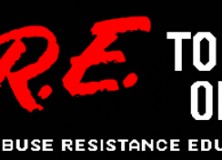Drug Abuse Resistance Education

The Sheriff’s Office is committed to educating students on the consequences of drug use and bullying.
These officers are the backbone of the D.A.R.E. program in area schools.

2012 TDOA State Training Conference at Paris Landing State Park – Thursday, July 12, 2012
(L to R) two DARE Role models from Henry County, Brianne Smith – DARE Youth Advisory Board Member, Bruce Alexander – Henry County School Resource Officers, Kim Smith – McKenzie School teacher, and Carroll County Sheriff Andy Dickson.
D.A.R.E. – May 9, 2012 – Clarksburg Essay Winner and Runner-up with Carroll County Sheriff Andy Dickson and Sheriff’s Office Public Information Officer Becky Keith.

D.A.R.E. – May 9, 2012 – Clarksburg Fifth Grade class, with teacher Janice Lewis.
 D.A.R.E. – March 2, 2012 – West Carroll Fifth Grade winners with Tennessee State Trooper Michael Sullivan and Public Information Officer Becky Keith.
D.A.R.E. – March 2, 2012 – West Carroll Fifth Grade winners with Tennessee State Trooper Michael Sullivan and Public Information Officer Becky Keith. D.A.R.E. – March 2, 2012 – West Carroll Fifth Grade runner-ups with Tennessee State Trooper Michael Sullivan and Public Information Officer Becky Keith.
D.A.R.E. – March 2, 2012 – West Carroll Fifth Grade runner-ups with Tennessee State Trooper Michael Sullivan and Public Information Officer Becky Keith.
Substance Abuse Fact Sheet
The leading surveys indicate a serious drug problem among today’s youth. Though trends of illicit drug use have leveled off in the last ten years, efforts to prevent substance abuse are still imperative. Successes such as the recent decline in youth tobacco use are important milestones for the prevention community.
- By the time a youth graduates from the 12th grade, there is a fifty percent chance that he or she has tried an illicit substance at least once.
- Adolescents who use alcohol and drugs are more likely to be victims or perpetrators of violence, engage in unplanned and unprotected sex, experience school failure, or be seriously injured from driving while impaired.
- Adolescents who use alcohol or illegal drugs are more likely to be at risk for suicide.
- Students who drink alcohol during adolescence have a reduced ability to learn, compared withthose youth who do not drink until adulthood. (Age-Dependent Inhibition Study)
- Alcohol and drug use are associated with poor academic performance, impaired development,mental health issues, and many other problems that affect youth.
- Recent findings regarding adolescent drug and alcohol use reveal that: 1) marijuana remains the most widely used illicit drug; 2) the illegal use of alcohol by minors is common; and 3) the use of drugs such as Ecstasy and steroids are rising. (2001 Monitoring the Future)
Monitoring the Future Survey1
- According to the 2001 Study, at least half of all youth have at least tried illicit drugs, alcohol, or tobacco by the time they finish high school.
- Six of ten 12th grade students report having been drunk at least once in their lifetime.
- One out of every four graduating high school seniors uses an illicit substance on a current or pastmonth basis. One in five use marijuana regularly.
- More than one quarter of 8th graders has used an illicit drug in their lifetime; about half of 10th graders and 12th grades have done so.
- Marijuana is the most commonly used illicit drug among all three grades, 9.2% of 8th graders, 19.8% of 10th graders, and 22.4% of 12th graders are current users.
- MDMA (ecstasy) has been one of the most rapidly rising drugs of abuse among youth in recent years – lifetime use among 12th graders doubled from 1998 to 2001.
- Unlike other drugs, inhalants are more frequently used by the youngest students, 4.0% percent of 8th graders are current users of inhalants, compared with 2.4% of 10th graders and 1.7% of 12th graders.
1 The Monitoring the Future (MTF) study, a school-based survey of 8th, 10th, and 12th graders conducted by the University of Michigan’s Institute for Social Research, is an important source of information on drug use among youth. The MTF has been collecting detailed information on drug use, drug-related attitudes and beliefs, and related factors on 12th graders since 1975 and on 8th and 10th graders since 1991. Selected findings from the 2001 survey are presented.
Additional Resources
Visit the TDOA website to learn about the Tennessee D.A.R.E. officers program Click here
Visit the state of Tennessee’s drug prevention website Click here
Learn about the deadly effects of methamphetamine and the battle to eradicate its use. Click here

